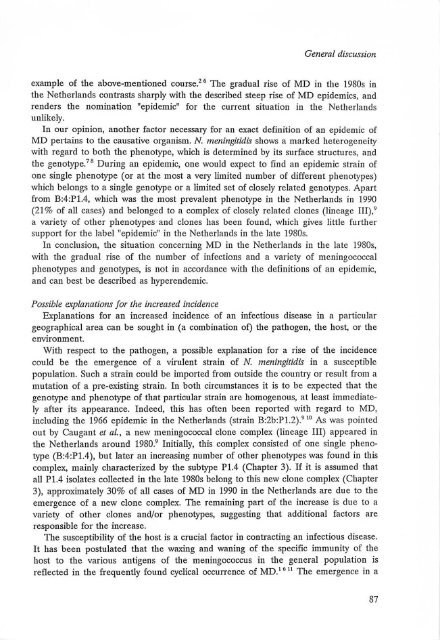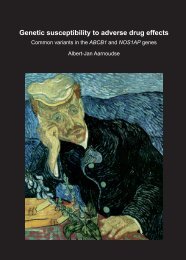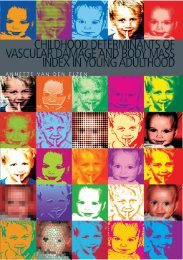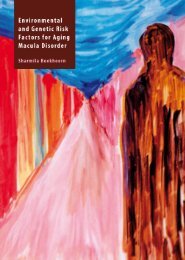An attempt at an epidemiological explanation - Epib.nl
An attempt at an epidemiological explanation - Epib.nl
An attempt at an epidemiological explanation - Epib.nl
- No tags were found...
Create successful ePaper yourself
Turn your PDF publications into a flip-book with our unique Google optimized e-Paper software.
General discussionexample of the above-mentioned course." Tbe gradual rise of MD in the 1980s inthe Netherl<strong>an</strong>ds contrasts sharply with the described steep rise of MD epidemics, <strong>an</strong>drenders the nomin<strong>at</strong>ion t1epidemict1 for the current situ<strong>at</strong>ion in the Netherl<strong>an</strong>dsu<strong>nl</strong>ikely.In our opinion, <strong>an</strong>other factor necessary for <strong>an</strong> exact definition of <strong>an</strong> epidemic ofMD pertains to the caus<strong>at</strong>ive org<strong>an</strong>ism. N. meningitidis shows a marked heterogeneitywith regard to both the phenotype, which is determined by its surface structures, <strong>an</strong>dtbe genotype.' 8 During <strong>an</strong> epidemic, one would expect to find <strong>an</strong> epidemic strain ofone single phenotype (or <strong>at</strong> the most a very limited number of different phenotypes)which belongs to a single genotype or a limited set of closely rel<strong>at</strong>ed genotypes. Apart(Tom B:4:P1.4, which was the most prevalent phenotype in the Netherl<strong>an</strong>ds in 1990(21 % of all cases) <strong>an</strong>d belonged to a complex of closely rel<strong>at</strong>ed clones (lineage llI),'a variety of other phenotypes· <strong>an</strong>d clones has been found, which gives little furthersupport for the label "epidemic" in the Netherl<strong>an</strong>ds in the l<strong>at</strong>e 1980s.In conclusion, the situ<strong>at</strong>ion concerning MD in the Netherl<strong>an</strong>ds in the l<strong>at</strong>e 19805,with the gradual rise of the number of infections <strong>an</strong>d a variety of meningococcalpbenotypes <strong>an</strong>d genotypes, is not in accord<strong>an</strong>ce with tbe definitions of <strong>an</strong> epidemic,<strong>an</strong>d c<strong>an</strong> best be described as hyperendemic.Possible expl<strong>an</strong><strong>at</strong>ions for the increased incidenceExpl<strong>an</strong><strong>at</strong>ions for <strong>an</strong> increased incidence of <strong>an</strong> infectious disease in a particulargeographical area c<strong>an</strong> be sought in (a combin<strong>at</strong>ion of) the p<strong>at</strong>hogen, the host, or theenvironment.With respect to the p<strong>at</strong>hogen, a possible expl<strong>an</strong><strong>at</strong>ion for a rise of the incidencecould be the emergence of a virulent strain of N. meningitidis in a susceptiblepopul<strong>at</strong>ion. Such a strain could be imported from outside the country or result from amut<strong>at</strong>ion of a pre-existing strain. In both circumst<strong>an</strong>ces it is to be expected th<strong>at</strong> thegenotype <strong>an</strong>d phenotype of th<strong>at</strong> particular strain are homogenous, <strong>at</strong> least immedi<strong>at</strong>elyafter its appear<strong>an</strong>ce. Indeed, this has often been reported with regard to MD,including the 1966 epidemic in the Netherl<strong>an</strong>ds (strain B:2b:P1.2)' 10 As was poi ntedout by Caug<strong>an</strong>t et aI., a new meningococcal clone complex (lineage Ill) appeared inthe Netherl<strong>an</strong>ds around 1980' Initially, this complex consisted of one single phenotype(B:4:P1.4), but l<strong>at</strong>er <strong>an</strong> increasing number of other pbenotypes was found in thiscomplex, mai<strong>nl</strong>y characterized by the subtype Pl.4 (Chapter 3). If it is assumed th<strong>at</strong>all Pl.4 isol<strong>at</strong>es collected in the l<strong>at</strong>e 1980s belong to this new clone complex (Chapter3), approxim<strong>at</strong>ely 30% of all cases of MD in 1990 in the Netherl<strong>an</strong>ds are due to tbeemergence of a new clone complex. The remaining part of the increase is due to avariety of other clones <strong>an</strong>d/or phenotypes, suggesting th<strong>at</strong> additional factors areresponsible for the increase.The susceptibility of tlle host is a crucial factor in contracting <strong>an</strong> infectious disease.It has been postul<strong>at</strong>ed th<strong>at</strong> the waxing <strong>an</strong>d w<strong>an</strong>ing of the specific immunity of thehost to the various <strong>an</strong>tigens of the meningococcus in the general popul<strong>at</strong>ion isreflected in the frequently found cyclical occurrence of MD.I 6 11 The emergence in a87









